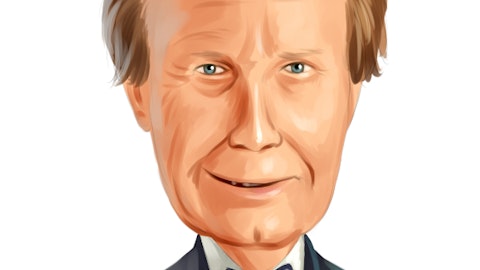Federated Hermes, Inc. (NYSE:FHI) Q4 2023 Earnings Call Transcript January 26, 2024
Federated Hermes, Inc. isn’t one of the 30 most popular stocks among hedge funds at the end of the third quarter (see the details here).
Operator: Greetings. Welcome to the Federated Hermes, Inc. Q4 2023 Analyst Call and Webcast. At this time, all participants are in a listen-only mode. A question-and-answer session will follow the formal presentation. [Operator Instructions] Please note this conference is being recorded. I will now turn the conference over to your host, Ray Hanley, President of Federated Investors Management Company. You may begin.
Raymond Hanley: Good morning, and welcome. Leading today’s call will be Chris Donahue, Federated Hermes President and CEO; and Tom Donahue, Chief Financial Officer. After some brief remarks we’ll open up for Q&A and participating in the Q&A will be Saker Nusseibeh, who is the CEO of the Federated Hermes Limited and Debbie Cunningham, the Chief Investment Officer for the money markets. During the call, we may make forward-looking statements, and we want to note that our actual results may materially different from the results implied by such statements. Please review our risk disclosures in our SEC filings. No assurance can be given as to future results, and Federated Hermes assumes no duty to update any of these forward-looking statements. Chris?
Christopher Donahue: Thank you, Ray, and good morning all. I will review Federated Hermes business performance and Tom will comment on the financial results. We had solid asset growth in Q4, ending with record assets under management of $758 billion, driven by record money market assets of $560 billion. Now looking first at equities, assets were up about $2 billion from Q3 to $79.3 billion, due to combined market gains and FX impact of $6.7 billion, but partially offset by net redemptions of $4.7 billion. We did see Q4 positive net sales in 11 equity strategies, including MDT Large Cap Growth, MDT Mid-Cap Growth, and international small-mid funds. Looking at our equity fund performance compared to peers and using Morningstar data for the trailing three years at the end of the year, 48% of our equity funds were beating peers, and 24% were in the top quartile in their category.
For the first three weeks of Q1, combined equity funds and SMAs had net redemptions of $319 million. Now turning to fixed income, assets increased by about $5.1 billion in Q4 to $94.9 billion, with fixed income separate accounts reaching a record high of $51 billion. Fixed income institutional separate accounts had net sales of $1.4 billion, led by corporates, multi-sector, and multi-sector. Fixed income SMAs had Q4 gross sales and net sales of $896 million and $584 million, respectively. Fixed income funds had net redemptions of about $988 million in Q4 and have had slightly positive net sales for the first three weeks of January. We had 12 fixed income funds with positive net sales in the fourth quarter, including the High Yield Bond Collective Investment Trust and the Sterling Cash Plus Fund.
We launched an actively managed ETF in the fourth quarter that uses a process similar to the core strategy of our Total Return Bond Fund. Regarding performance at the end of 2023 and using Morningstar data for the trailing three years, 31% of our fixed income funds were beating peers and 11% were in the top quartile of their category. For the first three weeks of Q1, combined, fixed income funds and SMAs had net sales of $105 million. In the alternative and private markets category, assets increased by $214 million in Q4 from the prior quarter to $20.6 billion due mainly to positive FX impact partially offset by market decreases. We are in the market with Horizon 3, the third vintage of our Horizon series of Global Private Equity Funds. As previously announced, Horizon 3 has closed on commitments of $100.05 billion through year end.

Hermes Innovation Fund II is also in the market. This is the second vintage of our pan-European growth private equity innovation fund. We had our first close in 2003 in August for approximately €100 million. And we’re also in the market with the first vintage of our U.K. Nature Impact Fund. We began 2024 with about $3.1 billion in net institutional mandates yet to fund into both funds and separate accounts. These wins are diversified across fixed income, equity and private markets. About $1.9 billion of net total wins is expected to come into private market strategies, including private equity, direct lending and unconstrained credit. Fixed income expected net additions total about $850 million with wins in the ultra-short, short duration, high yield and sustainable investment credit.
About $340 million of the net total wins is expected to come into equity strategies, including bio equity, global equity, GEMS which is the emerging markets ideas, and MDT Small Cap Core. Moving to money markets. We recently marked 50 years of innovation and successful management of money market funds as we launched the first fund to ever use the term money market on January 16th of 1974. At year-end 2023, we reached record highs for money market fund assets of $406 billion. Money market separate account assets of $154 billion and total money market assets of $560 billion. Total money market assets increased by $83 billion or 17% during 2003 and by $35 billion or 7% in the fourth quarter. Money market strategies continue to benefit from favorable market conditions for cash as an asset class, elevated liquidity levels in the financial system and attractive yields compared to cash management alternatives such as bank deposits and more recently direct investments in money market instruments such as T-bills and commercial paper.
In the expected upcoming period of declining short term rates, we believe that market conditions for money market strategies will continue to be favorable compared to direct market rates and bank deposit rates. Our estimate of money market mutual fund market share which includes sub-advised funds was about 7.4% at the end of 2023 up from about 7.3% at the end of the third quarter last year. Now, looking at recent asset totals as of a few days ago, managed assets were approximately $764 billion, including $568 billion in money markets, $78 billion in equities, $95 billion in fixed income, $20 billion in alternative private markets, and $3 billion in multi-asset. Money market mutual fund assets were at $406 billion. Tom?
Thomas Donahue: Thanks, Chris. Total revenue for Q4 decreased $11.2 million from the prior quarter, due mainly to lower average equity assets and lower total carried interest and performance fees. This is partially offset by higher average money market assets. Total Q4 carried interest and performance fees were $9.7 million, compared to $14.9 million in Q3. Q4 operating expenses decreased by $12.3 million from the prior quarter, due mainly to lower compensation expense related to carried interest in consolidated vehicles and lower incentive compensation expense. Advertising expense increased in Q4, due to the launch of our new campaign. The other operating expense line item decreased mainly due to the impact of FX. Looking ahead to Q1, certain seasonal factors will impact results.
The impact of fewer days is expected to result in about $4 million in lower operating income, all else being equal. In addition, based on our early assessment, compensation and related expense is expected to be higher than Q4, primarily to about $8 million of seasonally higher expense for stock compensation, payroll taxes, and base pay increases. We also expect to have higher incentive compensation expense. Of course, all these items will vary based on multiple factors. Holly, we would like to now open the call up for questions.
See also 12 Best German Dividend Stocks and 15 Stocks That Will Outperform the S&P 500 in 2024.
Q&A Session
Follow Federated Hermes Inc. (NYSE:FHI)
Follow Federated Hermes Inc. (NYSE:FHI)
Receive real-time insider trading and news alerts
Operator: Certainly. [Operator Instructions] One moment, please, while we poll for questions. Your first question for today is coming from Ken Worthington with JPMorgan Chase.
Ken Worthington: Hi. Good morning. Thanks for taking the question. Maybe starting particularly high level for you, Chris. I would like to ask you about strategy over the next three to five years. So maybe starting, what are the top two or three goals you have for the company? And then can you talk about your expectations for some of the businesses? In particular, I’m curious about what your goal is for the ESG franchise and the strategy there, and then the outlook and goals for the money market fund and the alternatives business.
Christopher Donahue: Okay. Let’s go in reverse. On the ESG, we’re doing more work in order to tag various ESG features to actual financial information and financial statements. This is not ready for prime time, but it’s a way to show the fluency that we have on this subject and further defend the integration of ESG concepts into the various funds where these features have been integrated as part of the risk-reward analysis. And we continue with that unabated. We also continue in the European spector to do what the clients want, which is to have sustainable funds that are going on beyond the regular fiduciary duty concepts that we have here in the U.S. So we are remaining where we were on that. We also believe that this will very much help on the risk-reward analysis across the board.
So we continue to go forward with that. On the money market funds, remember that over 50 years, we have had the strategy of keeping the money funds alive and well, and they work on the basis of higher highs and higher lows over all that time frame. And our dedication to it in terms of arguing with the SEC, dealing with the realities of the marketplace, have been well rewarded. These money market funds into the future will continue to serve as ballast for the ship of FHI, which it has done to date, noting that when there are variations in the marketplace, the money market funds prove the viability of a differentiated franchise for all seasons, and we continue to maintain that. And don’t forget that as the money supply is now back up, that is really the engine of monies going into money funds.
So we think that it is a permanent good long-term business. And in terms of top goals for various enterprises, the one way to look at the way we internally view growth in various spheres is simply double them all in five years. Now, that’s not going to happen on the money funds, but it’s certainly what we would establish as the goals for fixed income equity and especially private markets. And as I said to this group before, the private markets has the potential to be bigger than the fixed income and equity enterprise that we already manage here. And we have a lot of good things going on that side of the business. Now, mind you, it’s less than $20 billion, but nonetheless, they have all good records. The real estate is excellent. The private equity is excellent.
The private credit is excellent. And we’re working on the infrastructure deal. Now, there are other structures that we have to get right. And those are we like to provide the investment management. We are indifferent as to what the structure is. So now you see me mentioning about the ETF for total return bond fund. We have some more plans to add another handful onto our ETF offerings. And the idea is to make a full complement of ETF offerings as we go forward. And that will be a big move for us in the future. Don’t forget, these are active ETFs. And the active ETFs are only about 6% of the total ETF market. So we think there’s plenty of room to grow in those areas. I’m sure I skipped some of the other great goals that we have. But don’t forget, we’re spending tons of money on technology.
And to not have goals on getting that right would be a mistake.
Ken Worthington: Great. Thank you. And then maybe for Debbie, Chris called out the attractive yield and money market funds versus direct markets. So can you talk about the dynamics here and impact of PPP, QT, and the pivot, and what that sort of has on the outlook for the money market business?
Deborah Cunningham: Sure. I think what it does mostly is take the direction of flows and increase it more towards the institutional side. Doesn’t take away the retail side that has certainly been the driver of the flows in 2022 and 2023. But I think it emphasizes more the institutional side. And that is because in the context of what’s been happening from a pivot perspective with the yield curve itself, as well as expectations from a QT standpoint, you’ve seen what has been over the course of the last 18 months a fairly steep money market yield curve turn into something that’s relatively flat from a prime perspective and relatively inverted from two months out on the government side. And ultimately, that means that the institutional buyer of cash securities, of cash in some way, is going to go out of the securities market where they’ve been for the last 18 months and into something that holds on to the yield a little bit longer.





